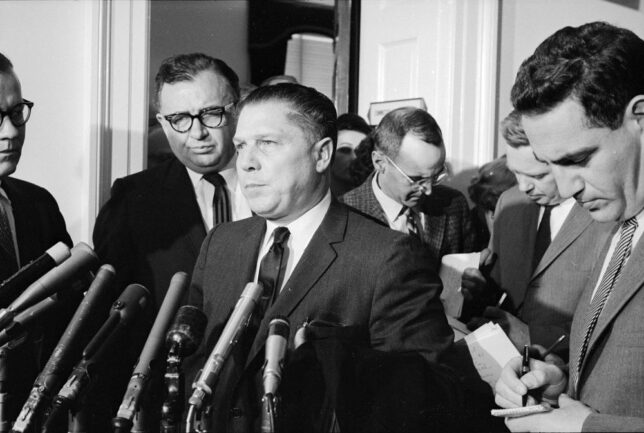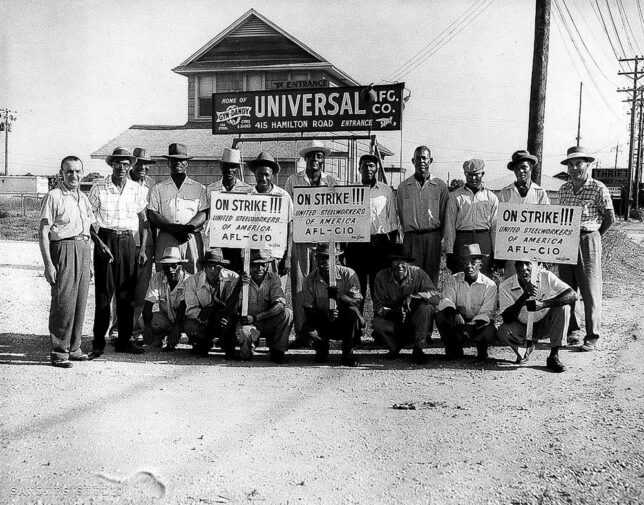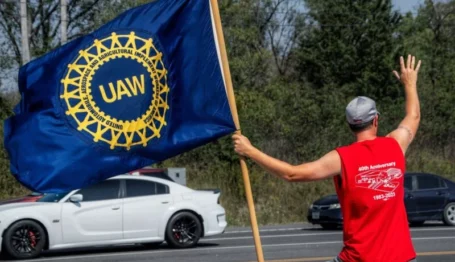Labor Watch
The Era of Labor Reform and Unionism’s Height: The Conservative Response
 The Rackets Committee exposed Jimmy Hoffa as a profoundly corrupt figure, even as he ascended to the national Teamsters presidency. Credit: Marion Trikosko. License: https://shorturl.at/dpMTZ.
The Rackets Committee exposed Jimmy Hoffa as a profoundly corrupt figure, even as he ascended to the national Teamsters presidency. Credit: Marion Trikosko. License: https://shorturl.at/dpMTZ.

The Era of Labor Reform and Unionism’s Height
The Conservative Response | The State of Big Labor, 1950
Labor’s Compromised Right | Responding to the Rackets
The period of organized labor’s ascendancy and consolidation after the Great Depression began to slow on November 5, 1946. In midterm elections held that day, the Republicans won their greatest congressional landslides in the post-Depression era, riding public discontent with postwar economic contractions and labor strife to a 12-seat gain in the Senate and 246 total seats in the House, breaking the Democratic trifecta for the first time since 1932. Over President Harry Truman’s veto, the ensuing Congress enacted the Taft-Hartley labor reforms, which expressly permitted right-to-work laws, subjected labor union unfair labor practices to scrutiny by the National Labor Relations Board, and restricted economically destructive “secondary” strikes.
While that Republican majority would prove fleeting and Truman would win an improbable re-election in 1948, Big Labor faced increasing headwinds as the Depression era retreated and the Cold War began. Labor reached its peak in the 1950s, just in time for congressional investigations to reveal corruption schemes in unions like the Teamsters that led to another round of legislation curtailing union power and increasing government scrutiny of labor union operations.
The 80th U.S. Congress has gone down in presidential campaign materials and histories that focus on the Presidency as the “do-nothing Congress” that helped President Harry Truman get re-elected. But in fact, that Congress elected in the midterm elections in 1946 was profoundly consequential and very much active.
Its most consequential acts included the Labor Management Relations Act of 1947, better known for the names of its House and Senate sponsors, Sen. Robert A. Taft (R-OH) and Rep. Fred Hartley (R-NJ). The Taft-Hartley Act established the consensus conservative Republican approach to labor relations for the next eight decades: restoring voluntarism to union membership, subjecting union internal operations to government scrutiny, and limiting the damage done to consumers and the economy from industrial action. It earned a veto from President Truman that was overridden by the congressional “conservative coalition” of majority Republicans and southern Democrats hostile to Big Labor.
While organized labor denounced Taft-Hartley Act as a “slave-labor law” and campaigned aggressively for President Truman’s re-election with an eye toward repealing it, the law survived. The 1950s would see unionism’s post–Wagner Act peak in membership density but revealed the seamy underbelly of Big Labor. Congressional investigators discovered organized crime control over some of the most powerful labor unions in the country, most notably the Teamsters, and radical unions in the Congress of Industrial Organizations (CIO) were infiltrated and dominated by Communists.
The threats from outside drove the House of Labor briefly into union, with the American Federation of Labor and Congress of Industrial Organizations agreeing to merge in 1955, forming the modern AFL-CIO. The happy House of Labor would not last. Corruption epitomized by Jimmy Hoffa’s rise to the union’s highest office led to the Teamsters—at the time the largest labor union in the country—being kicked out of the federation shortly thereafter. Meanwhile, Congress, led by the U.S. Senate Select Committee on Improper Activities in the Labor or Management Field under Sen. John McClellan (D-AR), conducted a wide-ranging investigation into the financial crimes of union leaders and how some, like Hoffa, had been compromised by organized crime.
By the end of the decade, the public and Congress had had enough. With the backing of President Dwight Eisenhower and despite large Democratic majorities in the House and Senate, Congress passed the Landrum-Griffin Act, which sought to combat the corruption the committee investigation had uncovered.
The Conservative Response Takes Shape: Taft-Hartley and Right-to-Work Laws
Conservatives and the Republican Party that serves as their imperfect political vehicle were mostly locked out of power from President Franklin Roosevelt’s landslide election in 1932 through his death in 1945. But after the end of World War II, the New Deal Democrats now led by President Truman finally hit the threshold of political exhaustion as their organized labor allies reached for too much too quickly.
Wartime labor relations were governed by a set of pacts agreed between Big Business, Big Labor, and FDR’s Big Government, the most important of which was a no-strike/no-lockout pledge. Most, but not all, major unions abided by the pledge: The most notable dissenters were the United Mine Workers led by John L. Lewis, who had fallen out with Roosevelt over politics.
But with V-J Day came the end of the pledge. And with the end of the pledge came an attempt by Big Labor to flex its New Deal–enhanced muscles, as it led the largest wave of strikes in American history. That effort combined with general economic disruptions brought the first federal Republicans to power in the post-Depression era with the 80th U.S. Congress.
Since the strike wave had contributed to the Republican sweeps in the 1946 midterms, labor relations reform was at the top of the new majority’s agenda. House Republicans, who were more ideologically conservative, took the lead, with Education and Labor Committee chairman Rep. Fred Hartley (R-NJ) advancing an aggressive reform proposal.

Wartime labor relations were governed by a set of pacts agreed upon between Big Business, Big Labor, and President Franklin Roosevelt’s Big Government, the most important of which was a no-strike/no-lockout pledge. But with V-J Day came the end of the pledge and an attempt by Big Labor to flex its New Deal–enhanced muscles, as it led the largest wave of strikes in American history. Credit: Penn State Special Collections. License: https://shorturl.at/ekowx.
The bill passed the House of Representatives with a veto-proof majority, and then action moved to the Senate, where Senate Republican Policy Committee and Senate Labor and Public Welfare Committee chairman Sen. Robert Taft (R-OH), a leader of the national GOP’s conservative faction, guided more moderate legislation through his ideologically divided conference. Both houses then passed the final bill over President Truman’s veto with strong bipartisan majorities. In the House of Representatives, a majority of Democrats backed the veto override; in the Senate, Democrats split nearly evenly.
As its bipartisan support might indicate, the Taft-Hartley legislation was not nearly as radical as Big Labor claimed in its campaign against the supposed “Slave-Labor Law.” The legislation left the fundamental nature of the National Labor Relations Act alone. Exclusive monopoly bargaining, under which a recognized union may demand the power to negotiate on behalf of all workers in a bargaining unit, not just union members, was preserved as the national default. Employer bargaining in “good faith” with a majority-status union remained required by law. There would be no return to the era of the labor injunction and the true, union-prohibited “open shop,” even in concept. In the words of the National Right to Work Committee’s official history, passing Taft-Hartley was “like giving a baby aspirin to someone with a migraine.”
Instead of a return to the pre–National Labor Relations Act era, Taft-Hartley stipulated that the liberal regime of the New Deal era would be administered subject to conservative restrictions. Unions would have reciprocal obligations to bargain in good faith to those that the Wagner Act had placed on employers. Certain strikes over union jurisdiction and against third parties to labor disputes were banned. The president was given additional power to intervene in labor disputes in national emergencies. Communists were banned from holding union offices, though this rule would be curtailed by later Supreme Court rulings.
Perhaps the most remembered legacy of the Taft-Hartley Act was its restrictions on “closed shops,” contract provisions requiring union membership. “Closed shop” agreements requiring hiring union members exclusively were banned. States gained the explicit power to pass “right-to-work” laws prohibiting conditioning employment on the payment of any union dues or fees.
Together, Taft-Hartley’s provisions became the basis for an eight-decade consensus within the conservative movement on labor relations policy that affirmed the need to make union membership and participation voluntary, to subject union conduct to government oversight and regulation, and to protect the public from fallout from labor disputes.
Big Labor and its Democratic allies reacted viciously to the passage of Taft-Hartley. Buoyed by President Truman’s veto, the unions went all out to elect Truman and pro-union candidates in 1948, with the hope of repealing the law. While the electorate ushered in a Democratic trifecta that year, Taft-Hartley would survive with few amendments, forming the administrative frame for labor relations that continues through the present day.
In the next installment, organized labor reached its apogee in the mid-20th century.



